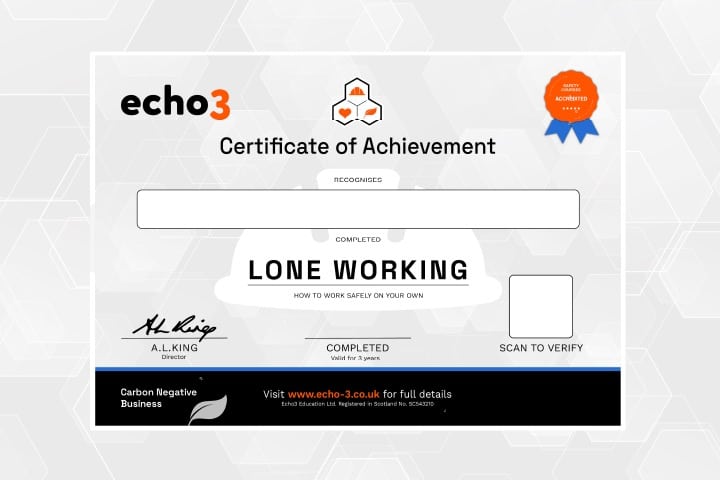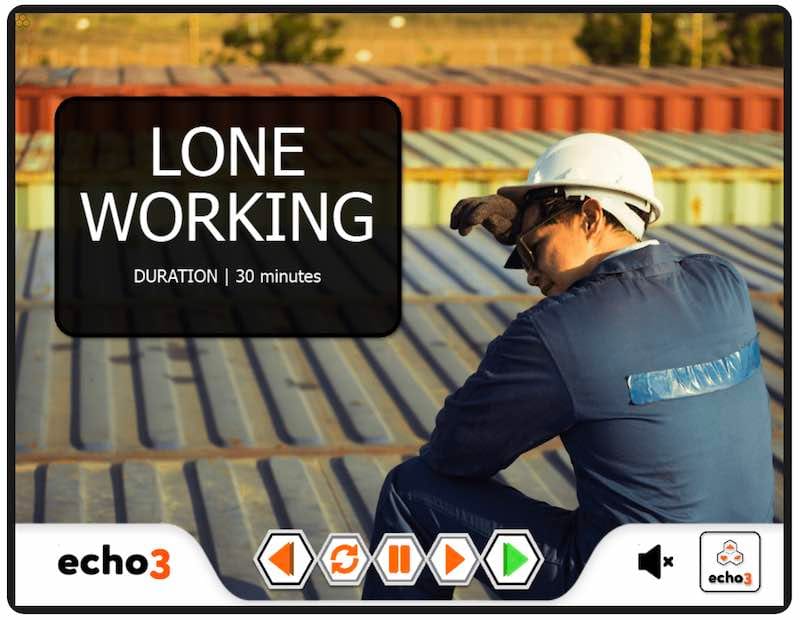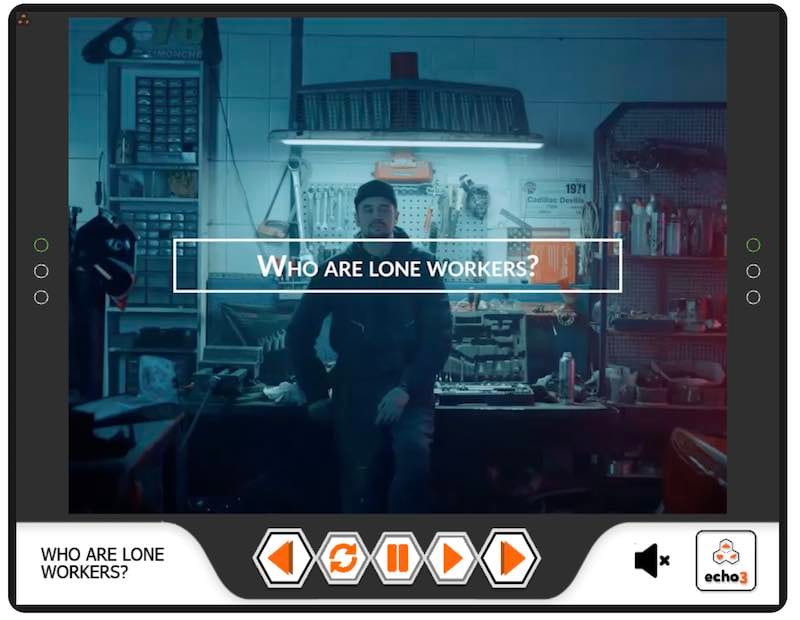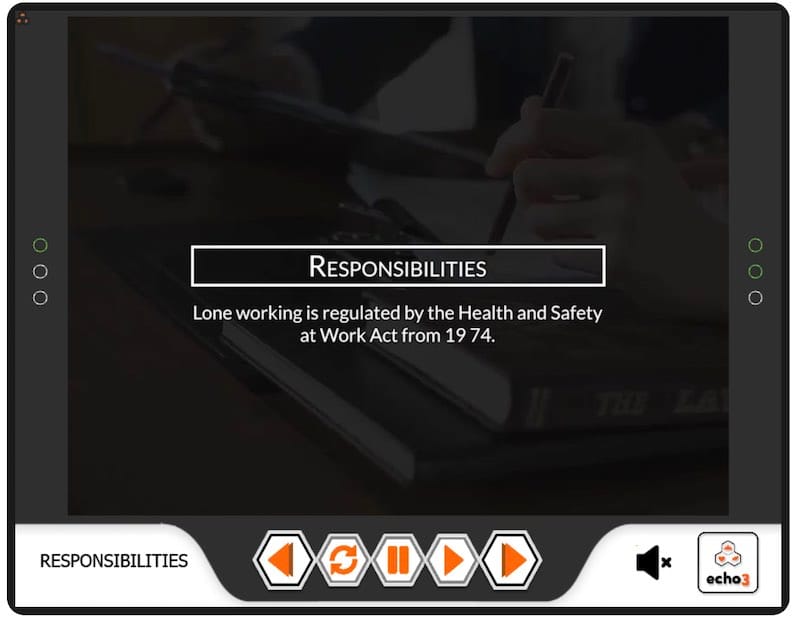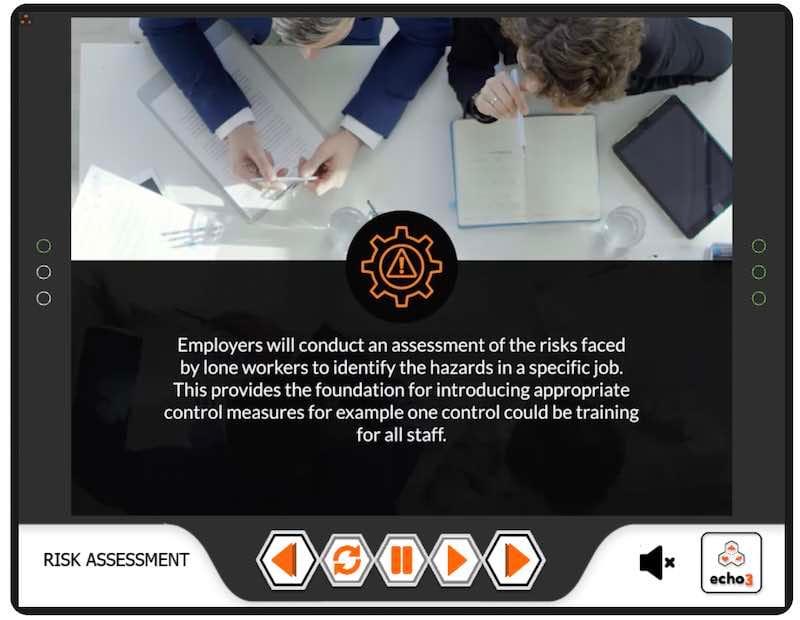Your basket is currently empty!

Lone Working Course
Online Lone Working course designed for everyone who works alone. Provides the knowledge needed to work safely remotely. Certificate emailed on successful completion.
- For Me
- For Team
LONE WORKING COURSE
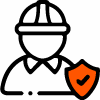 Lone workers face increased risks including accidents without immediate assistance, health issues going unnoticed, vulnerability to harassment or violence, and the psychological impact of isolation and lack of support.
Lone workers face increased risks including accidents without immediate assistance, health issues going unnoticed, vulnerability to harassment or violence, and the psychological impact of isolation and lack of support.
This online lone working course equips individuals with the knowledge to successfully navigate the challenges of working alone.
The Echo3 Lone Working course cover crucial aspects like risk assessment, safety protocols, communication strategies, and emergency procedures tailored to solitary work environments.
Understanding these principles enhances safety, reduces risks, develops a proactive mindset for handling workplace hazards and helps employers meet regulatory requirements.
COURSE OBJECTIVES
 The course objectives for an online lone working course include a general understanding of safety measures tailored to solitary work environments. Specific course objectives include:
The course objectives for an online lone working course include a general understanding of safety measures tailored to solitary work environments. Specific course objectives include:
Risk Assessment. Teaching individuals the purpose of risk assessments for lone workers and the importance of adhering to control measures.
Safety Protocols. Providing knowledge on appropriate safety control measures and how they will help to mitigate risks.
Communication Strategies. Educating on effective communication methods for seeking help or support during emergencies.
Legal Compliance. Understanding legal obligations and compliance standards related to lone working.
Emergency Procedures. Equipping individuals with the necessary skills to handle emergencies and make informed decisions autonomously.
Enhanced Preparedness. Fostering a proactive mindset to anticipate and manage potential challenges when working alone.
Overall, these objectives aim to empower individuals with the knowledge, and confidence to navigate solitary work environments safely and effectively.
WHO IS THIS COURSE FOR?
 The Echo3 online lone working course is beneficial for anyone operating in isolated or independent work settings.
The Echo3 online lone working course is beneficial for anyone operating in isolated or independent work settings.
This included freelancers, remote workers, field researchers, healthcare professionals in remote clinics, security guards, delivery personnel, and those in industries like agriculture or forestry.
It’s particularly essential for individuals whose work involves inherent risks, such as working in hazardous environments, late-night shifts, or situations where help might not be readily available.
Employers responsible for the safety of lone workers can easily send this training to their employees. Contact us for administration options – [email protected].
LONE WORKING COURSE CONTENT
 UNIT 1 | INTRODUCTION TO LONE WORKING
UNIT 1 | INTRODUCTION TO LONE WORKING
In this first unit we’ll define what a ‘lone worker’ is. We highlight the 2 different types of lone workers and list the responsibilities of employers and employees.
UNIT 2 | RISKS OF LONE WORKING
In this second unit we will cover some of the common workplace hazards faced by lone workers in various jobs. Because the first step in remaining safe is understanding potential hazards or dangers that exist.
UNIT 3 | SAFE LONE WORKING
In this final 3rd unit we outline the control measures that employers can put in place to help keep lone workers safe.
LONE WORKING CERTIFICATE
Echo3 certification in Lone Working ensures a thorough understanding of equipment regulations, enhancing compliance proficiency.
The CPD accreditation is a sign of engaging, high-quality and up-to-date training.
Once participants achieve 80% or more in the final 10 questions multiple-choice assessment, we will email the completion certificate. The Lone Working certificate is valid for 3 years.
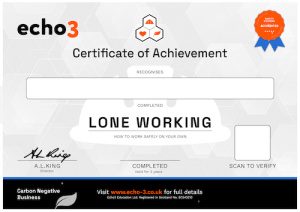
ECHO3 BENEFITS
 Taking the Lone Working training course from Echo3 offers your organisation several benefits.
Taking the Lone Working training course from Echo3 offers your organisation several benefits.
Great Value. Echo3 strive to offer organisation the best value online health & safety training.
Engaging Learning. The course comprises motion graphic videos that are interesting & memorable.
Simple Administration. Purchase the course to immediately complete yourself or email to colleagues. If you have a lot of learners or staff without emails contact us. We can find a training solution that works for you.
Carbon-negative. Echo3 fully offset their carbon footprint. Meaning if you choose our safety courses, you will in turn be reducing the carbon footprint of your own training.

WHO ARE LONE WORKERS?
Anybody who works alone, including contractors, and the self-employed.
In the UK alone, 19% of the working population are considered to be lone workers.
There are 2 types of lone workers. Fixed Site and Mobile Workers.
Fixed site workers are employees who work in fixed establishments, who either work by themselves, or work outside normal hours.
For Example
- A person working alone in a small workshop, petrol station, or shop.
While Mobile workers work away from a fixed base or head office.
Examples of mobile workers include;
- Those who working in remote areas for example agriculture and forestry workers.
- Potentially those in construction, maintenance or cleaning work.
- Those working from home.
- Often staff working outside normal hours, such as security staff and petrol station workers.

LONE WORKING HAZARDS BY SECTOR
Transportation employees
In the transport sector, Lone workers like bus or taxi drivers could be exposed to robberies , road accidents, road rage incidents, sprain and strain injuries, verbal and physical assault and anti-social behaviour from angry passengers.
Health Care
Lone healthcare workers such as carers, are mainly exposed to lifting injuries and drug handling hazards like needle stick injuries and blood borne pathogens.
But also again they are at risk of robberies, verbal and physical assault from patients and drug handling.
Retail
Lone retail workers can be exposed to lifting injuries, and again robberies and verbal and physical assault from customers.
Cleaning
Cleaners often work with hazardous substances like bleach. So lone working cleaners need to be trained about the nature of the substances and materials they work with, the risks created by exposure to those substances and the precautions to take.
The construction industry
The construction sector is one of the world’s most dangerous industries, accounting for numerous workplace injuries and fatalities each year. Lone construction workers can be exposed to falling from height, lifting and other work-related injuries, theft of equipment and operating equipment.
Homeworkers
Homeworkers are those who use their home as their place of work for the majority of the time. An employer has the same responsibility for home workers as for any other employees.
When working with Display Screen Equipment or DSE it is important for a homeworker to adjust their work station to a comfortable position and take frequent short breaks from work.
LONE WORKING COURSE
 Lone workers face increased risks including accidents without immediate assistance, health issues going unnoticed, vulnerability to harassment or violence, and the psychological impact of isolation and lack of support.
Lone workers face increased risks including accidents without immediate assistance, health issues going unnoticed, vulnerability to harassment or violence, and the psychological impact of isolation and lack of support.
This online lone working course equips individuals with the knowledge to successfully navigate the challenges of working alone.
The Echo3 Lone Working course cover crucial aspects like risk assessment, safety protocols, communication strategies, and emergency procedures tailored to solitary work environments.
Understanding these principles enhances safety, reduces risks, develops a proactive mindset for handling workplace hazards and helps employers meet regulatory requirements.
COURSE OBJECTIVES
 The course objectives for an online lone working course include a general understanding of safety measures tailored to solitary work environments. Specific course objectives include:
The course objectives for an online lone working course include a general understanding of safety measures tailored to solitary work environments. Specific course objectives include:
Risk Assessment. Teaching individuals the purpose of risk assessments for lone workers and the importance of adhering to control measures.
Safety Protocols. Providing knowledge on appropriate safety control measures and how they will help to mitigate risks.
Communication Strategies. Educating on effective communication methods for seeking help or support during emergencies.
Legal Compliance. Understanding legal obligations and compliance standards related to lone working.
Emergency Procedures. Equipping individuals with the necessary skills to handle emergencies and make informed decisions autonomously.
Enhanced Preparedness. Fostering a proactive mindset to anticipate and manage potential challenges when working alone.
Overall, these objectives aim to empower individuals with the knowledge, and confidence to navigate solitary work environments safely and effectively.
WHO IS THIS COURSE FOR?
 The Echo3 online lone working course is beneficial for anyone operating in isolated or independent work settings.
The Echo3 online lone working course is beneficial for anyone operating in isolated or independent work settings.
This included freelancers, remote workers, field researchers, healthcare professionals in remote clinics, security guards, delivery personnel, and those in industries like agriculture or forestry.
It’s particularly essential for individuals whose work involves inherent risks, such as working in hazardous environments, late-night shifts, or situations where help might not be readily available.
Employers responsible for the safety of lone workers can easily send this training to their employees. Contact us for administration options – [email protected].
LONE WORKING COURSE CONTENT
 UNIT 1 | INTRODUCTION TO LONE WORKING
UNIT 1 | INTRODUCTION TO LONE WORKING
In this first unit we’ll define what a ‘lone worker’ is. We highlight the 2 different types of lone workers and list the responsibilities of employers and employees.
UNIT 2 | RISKS OF LONE WORKING
In this second unit we will cover some of the common workplace hazards faced by lone workers in various jobs. Because the first step in remaining safe is understanding potential hazards or dangers that exist.
UNIT 3 | SAFE LONE WORKING
In this final 3rd unit we outline the control measures that employers can put in place to help keep lone workers safe.
LONE WORKING CERTIFICATE
Echo3 certification in Lone Working ensures a thorough understanding of equipment regulations, enhancing compliance proficiency.
The CPD accreditation is a sign of engaging, high-quality and up-to-date training.
Once participants achieve 80% or more in the final 10 questions multiple-choice assessment, we will email the completion certificate. The Lone Working certificate is valid for 3 years.

ECHO3 BENEFITS
 Taking the Lone Working training course from Echo3 offers your organisation several benefits.
Taking the Lone Working training course from Echo3 offers your organisation several benefits.
Great Value. Echo3 strive to offer organisation the best value online health & safety training.
Engaging Learning. The course comprises motion graphic videos that are interesting & memorable.
Simple Administration. Purchase the course to immediately complete yourself or email to colleagues. If you have a lot of learners or staff without emails contact us. We can find a training solution that works for you.
Carbon-negative. Echo3 fully offset their carbon footprint. Meaning if you choose our safety courses, you will in turn be reducing the carbon footprint of your own training.

WHO ARE LONE WORKERS?
Anybody who works alone, including contractors, and the self-employed.
In the UK alone, 19% of the working population are considered to be lone workers.
There are 2 types of lone workers. Fixed Site and Mobile Workers.
Fixed site workers are employees who work in fixed establishments, who either work by themselves, or work outside normal hours.
For Example
- A person working alone in a small workshop, petrol station, or shop.
While Mobile workers work away from a fixed base or head office.
Examples of mobile workers include;
- Those who working in remote areas for example agriculture and forestry workers.
- Potentially those in construction, maintenance or cleaning work.
- Those working from home.
- Often staff working outside normal hours, such as security staff and petrol station workers.

LONE WORKING HAZARDS BY SECTOR
Transportation employees
In the transport sector, Lone workers like bus or taxi drivers could be exposed to robberies , road accidents, road rage incidents, sprain and strain injuries, verbal and physical assault and anti-social behaviour from angry passengers.
Health Care
Lone healthcare workers such as carers, are mainly exposed to lifting injuries and drug handling hazards like needle stick injuries and blood borne pathogens.
But also again they are at risk of robberies, verbal and physical assault from patients and drug handling.
Retail
Lone retail workers can be exposed to lifting injuries, and again robberies and verbal and physical assault from customers.
Cleaning
Cleaners often work with hazardous substances like bleach. So lone working cleaners need to be trained about the nature of the substances and materials they work with, the risks created by exposure to those substances and the precautions to take.
The construction industry
The construction sector is one of the world’s most dangerous industries, accounting for numerous workplace injuries and fatalities each year. Lone construction workers can be exposed to falling from height, lifting and other work-related injuries, theft of equipment and operating equipment.
Homeworkers
Homeworkers are those who use their home as their place of work for the majority of the time. An employer has the same responsibility for home workers as for any other employees.
When working with Display Screen Equipment or DSE it is important for a homeworker to adjust their work station to a comfortable position and take frequent short breaks from work.




